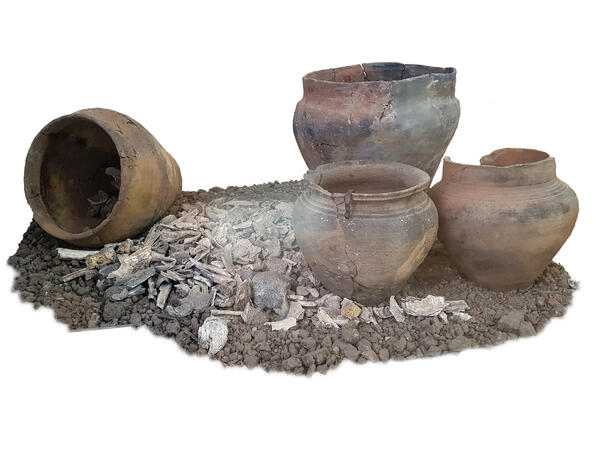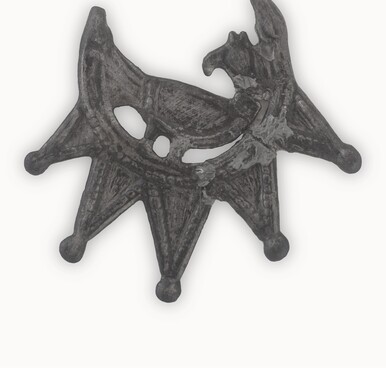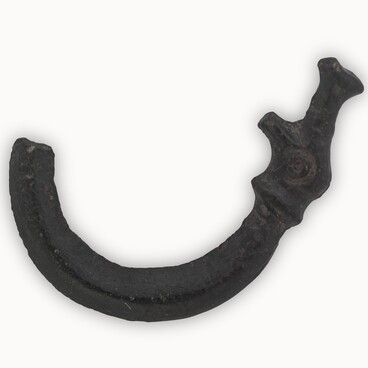The Kursk Museum of Archaeology shows an installation showing a pagan burial with the rite of “cremation afield”. Such a rite was common among various pagan tribes: the remains of the deceased were first burned and then buried in shallow pits.
In 1998, an expedition of the Kursk Museum of Archaeology led by the Kursk historian and archaeologist Alexander Vasilievich Zorin examined the burial mound near the village of Shuklinka of the Kursk district of the Kursk region. The mound had a hemispherical shape with a height of 2.8 m and a diameter of 18 m. At the base of the mound there was a layer of light gray soil on which there were clear prints of stems of decayed plants, which covered the surface during the funeral rites. The area covered with stalks of cereal plants was enclosed by a low rampart up to 0.7 m high, which was covered with bright yellow clay from above. A passage was left in the clay rampart in the south-western part. Outside, pillars had been dug in on the four sides of the rampart and fires had been built around them. In the mound a ritual stove or “fire pit” was discovered where fires were also made.
Ritual fires were lit from the edge of the mound, which left behind large clusters of coals and charcoal logs. In the lower layers of the mound, in the dense light gray soil, a white metal ring was found. The burial was an accumulation of calcified bones mixed with the bones of burnt sacrificial animals. Their total weight was 2.4 kg. Two molded and two circular vessels accompanying the cluster also contained calcified bones inside, which occupied at least one third of the inner volume of each pot.
According to Alexander Vasilievich Zorin, such a specific mound and accompanying burial tools served at least three purposes: to magically cleanse the place, to neutralize the deceased and to ensure the transition of the deceased to the afterlife and his settling in a new place. The burial mound is dated to the late 10th century. It should be noted that burials of this type have analogues in the form of burial mounds in more northern regions. The mounds, formed by systematically adding and increasing the size of the horseshoe-shaped rampart, are characteristic of the Novgorod hillocks and the mounds of the Ladoga Ves’ (located next to Lake Ladoga).
In 1998, an expedition of the Kursk Museum of Archaeology led by the Kursk historian and archaeologist Alexander Vasilievich Zorin examined the burial mound near the village of Shuklinka of the Kursk district of the Kursk region. The mound had a hemispherical shape with a height of 2.8 m and a diameter of 18 m. At the base of the mound there was a layer of light gray soil on which there were clear prints of stems of decayed plants, which covered the surface during the funeral rites. The area covered with stalks of cereal plants was enclosed by a low rampart up to 0.7 m high, which was covered with bright yellow clay from above. A passage was left in the clay rampart in the south-western part. Outside, pillars had been dug in on the four sides of the rampart and fires had been built around them. In the mound a ritual stove or “fire pit” was discovered where fires were also made.
Ritual fires were lit from the edge of the mound, which left behind large clusters of coals and charcoal logs. In the lower layers of the mound, in the dense light gray soil, a white metal ring was found. The burial was an accumulation of calcified bones mixed with the bones of burnt sacrificial animals. Their total weight was 2.4 kg. Two molded and two circular vessels accompanying the cluster also contained calcified bones inside, which occupied at least one third of the inner volume of each pot.
According to Alexander Vasilievich Zorin, such a specific mound and accompanying burial tools served at least three purposes: to magically cleanse the place, to neutralize the deceased and to ensure the transition of the deceased to the afterlife and his settling in a new place. The burial mound is dated to the late 10th century. It should be noted that burials of this type have analogues in the form of burial mounds in more northern regions. The mounds, formed by systematically adding and increasing the size of the horseshoe-shaped rampart, are characteristic of the Novgorod hillocks and the mounds of the Ladoga Ves’ (located next to Lake Ladoga).




